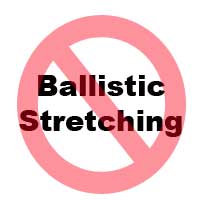Stretching Dos and Donts
Flexibility training is an integral part of a good flexibility program. To minimize injury and maximize the benefit you get from your program I will lay out the stretching dos and doníts of flexibility training.
Unfortunately many people get caught up in the way their parents did exercise. Most peopleís warm up looks like this. Five to Ten minutes on a bike or jog followed by static stretching. This is old school. Itís time for new updated stretching programs. Because many people are still caught in the old through really no fault of their own, I will educate you on modern principles of stretching in hopes of helping you change your ways. Can you teach and old dog new tricks? Yes. Will they listen and do what is taught? That is up to you.
You will see a theme of some sorts as you navigate the website content. Many aspects will try to divert you from old outdated habits to newer more modern habits. For example, no longer does a warm up consist of riding a stationary bike for 10 minutes then static stretching. It is more than that.
Open your mind and discover the better life that can be yours if you follow these good tips and don't follow the bad ones listed below. This is by no means an all inclusive list of stretching dos and don'ts
Dos
- Foam Rolling
- Stretch 5-6 days a week
- Integrated Flexibility
DONTS
- Ballistic Stretching
- Only Static Stretching before exercise
- No Pain No Gain
- Competing
- Donít Stretch too far
- Stretching Contraindications
DO's
Foam Rolling- Foam rolling is a modern principle of stretching. You should do this every time before you exercise. Foam rolling should come before static stretching or dynamic stretching. Muscles have a tendency to develop knots. One of the best ways to get rid of these knots is through foam rolling. Foam rolling is like self message. It will improve the quality of your muscles and prepare them for other types of flexibility training to follow. You should not only rely on foam but also tennis balls, golf balls and massage sticks for this type of flexibility training. The part of the body that needs rolling will dictate the tool used. To learn more about rolling read the rolling article.
Stretch 5-6 Days a week-Stretch almost every day. This will keep you flexible. If you are not flexible, it will improve it.
Use Multiple Methods of Flexibility-You should not rely on one method to increase flexibility before activity. The NASM says ďresearch that is currently underway at the University of North Carolina is beginning to show that a systematic approach that includes inhibition (foam roll), lengthening (static stretching), activation (active stretching), and integration (dynamic stretching) may improve human movement imbalances, decrease injury risk, and improve performance. In addition, empirical data from the Phoenix Suns (whose entire basketball team and staff have adopted and implemented this integrated approach) has proven that following an integrated, systematic flexibility training system (inhibit, lengthen, activate, integrate) may significantly decrease injuries (the Phoenix Suns had the fewest number of games missed to injuries in the entire NBA during the 2006Ė07 season).Ē 1 The official stance of this website is before each exercise routine you should foam roll, Static Stretch then Dynamic stretch, in that order.
Doníts
Ballistic Stretch- Ballistic stretching is not a good idea. The bodies built in physiology mechanism make ballistic stretching potentially harmful. The muscle spindles are sensitive to changes in length and velocity. So when stretching quickly through bouncing movements the muscle spindle will activate and increase tension in the muscle. In addition to that you possibly can go beyond the limits of flexibility imposed by the muscles. In my mind, increased tension as well the possibility of going beyond the limit of flexibility can cause damage to the muscle. Not a chance you should take. Ballistic Stretching is out!
imposed by the muscles. In my mind, increased tension as well the possibility of going beyond the limit of flexibility can cause damage to the muscle. Not a chance you should take. Ballistic Stretching is out!
Static Stretching only before exercise-If you read the article on dynamic stretching you understood how static stretching in essence puts the muscles to sleep. It doesnít make sense to start an activity by shutting down the muscles. The whole purpose of your warm up is to warm-up, loosen, activate and wake up the body. If you only choose static stretching you are putting the muscles to sleep.
No Pain No Gain-Wrong! If you feel pain something is wrong. The old adage no pain no gain is not correct, especially in stretching. You should feel slight discomfort but not pain. Image feeling a sharp pain down your hamstring during a stretch, does this mean you achieved a good stretch? No. It could mean something much worse. Consult with a physician if you encounter major pains while stretching.
Donít stretch too far-To prevent excessive pain and injury donít stretch too far. Remember, one purpose of stretching is injury reduction. If stretching causes pain youíve gone too far.
Stretching Contraindications-Following injury, surgery and during pregnancy make sure you consult with a doctor. Avoiding injury is the key. It would be a shame to re-injure, re-aggravate or cause damage during pregnancy by not following the advice of your doctor.
Competition in Stretching is bad- Each personís flexibility limits are different. If John who can only stretch 30 Degrees attempts to surpass Janeís 50 degree stretching limit, john is setting himself up for injury. Compete in sports and activities, not flexibility.
References: Medicine, N. A. Integrated Flexibility Training. In M. Clark. Page 44
